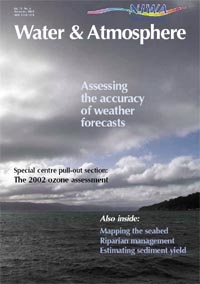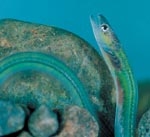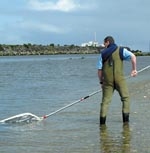PDF of this article (85 KB)

Don Jellyman Paul Lambert
When is the best time to fish for juvenile eels for use in aquaculture?

All 15 species of freshwater eel spawn at sea. The leaf-shaped larvae, the leptocephalus, drifts back to land over a period of many months. Before entering fresh water, the leptocephalus metamorphoses into a juvenile transparent eel, hence the name glass eel (see Water & Atmosphere 8(4): 21–22). These juvenile eels arrive in river mouths around New Zealand during spring each year.
The international eel aquaculture industry, with an annual production of over 230,000 tonnes, relies almost totally upon wild glass eels as the seed stock. Although eel aquaculture in New Zealand is still in its infancy, access to reliable sources of glass eels is imperative to development of the industry. It is also important to have an understanding of the conditions that favour the arrival of glass eels in fresh water, so that fishing can be targeted to these times.
Glass eel surveys

To investigate glass eel arrival times and patterns, in 2000 and 2001 we sampled the Grey River on the South Island’s west coast during September to November. Previous research has indicated that this is the major arrival period. Although large-scale harvest of glass eels would normally involve use of a large set net, we opted for a modified whitebait dragnet.
We know that glass eels arriving for the first time prefer to migrate during darkness, so fishing started 15 minutes before sunset, and continued for three hours. A 10-metre sweep was made every five minutes, and any glass eels captured were counted into a floating live box. At the end of an evening’s fishing, the total catch was released well above the sampling site.
Because we needed to relate numbers of glass eels caught on a given night to environmental conditions, we measured river water temperature and clarity, and cloud cover, and noted overall weather and sea conditions. We also had access to data on sea temperatures, times of high tide and sunset, moon phase, and river discharge.
Every two weeks a few samples of glass eels were taken back to the laboratory. Here we examined individual fish to get an idea of species composition, pigmentation stages (an indication of the length of time eels have been in fresh water), and average weight.
Effects of tide, moon phase and water clarity
Over the two years we caught almost 5000 glass eels, although the catch rate in 2000 was almost twice that of the following year. Shortfin glass eels predominated (97%), and the average size and weight of both species decreased over the three-month sampling period. Most glass eels were caught during October (see graph – click to enlarge). In both years the peak fishing period was one to two hours after sunset . The only pre-sunset catches made were during a flood when the river was discoloured.

Highest catches were made on the incoming tide, especially on spring tides. But there was a difference between the years. Higher catches were seen around spring tides of both full and new moons in 2000, but only on new moon spring tides in 2001. This difference can be explained by the higher flows and lower water clarity during 2000. Daylight or bright moonlight inhibits the movement of glass eels. Therefore, the lower water clarities in 2000 would have reduced any inhibitory effect when the moon was full. Generally clearer water in 2001 made it less likely that migrations would take place under a full moon.
Behaviour changes
We caught our glass eels very close to the mouth of the river, but we know from previous studies that the behaviour of glass eels changes according to the length of time they have spent in fresh water. Glass eels arriving directly from the sea use flood tides to provide passive transport upstream. At this stage – as we found in the Grey River – glass eels avoid light. Farther upstream migration is then delayed as the eels undergo some physiological adaptations. When migration starts again a week or so later, the juvenile eels are less inhibited by daylight and actively swim upstream.
For aquaculture, the early-season glass eels are preferred to later-season ones, as the earlier arrivals are larger and in better condition. Likewise, there is a slight preference for catching glass eels near river mouths rather than from farther upstream, as newly arrived glass eels are virtually disease-free, having had little time to pick up any freshwater diseases.
This second migration is the more convenient stage for capture, as the eels often move during the day in large shoals, which the ebb tide forces close to the river bank.
The Waikato River has the largest runs of glass eels of any New Zealand river. They are best observed and caught at least 10 km upstream of the river mouth, where history records shoals of glass eels running continuously for several days and nights.
In future it will be important to find whether the predictions of peak fishing times we established for the Grey River can also be applied to the Waikato, where flows in the lower river are modified by the operation of upstream hydro dams.
Teachers: this article can be used for NCEA Achievement Standards in Biology (2.2, 2.5, 3.4). See other curriculum connections at www.niwa.co.nz/pubs/wa/resources
Don Jellyman is based at NIWA in Christchurch; Paul Lambert is at NIWA in Greymouth.
